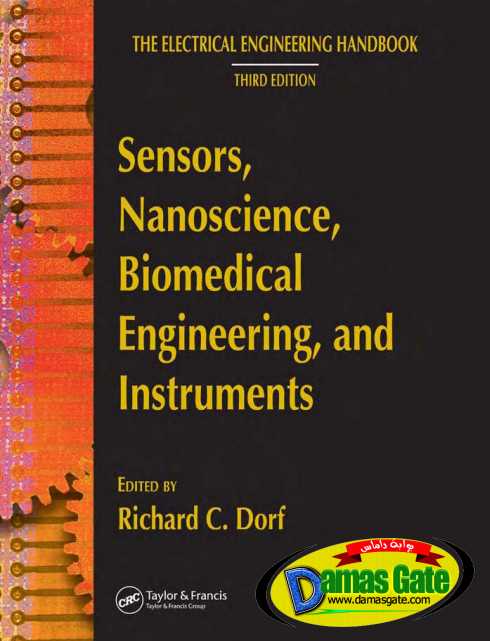Sensors, Nanoscience, Biomedical Engineering, and Instruments

Introduction
Rosemary L. Smith
Sensors are critical componentsinall measurementand control systems. The need for sensors that generate an
electronic signal closely followed the advent of the microprocessor and computers. To gether withthe everpresent
need for sensors in science and medicine, the demand for sensors in automated manufacturing and
environmentalmonitoring is rapidly growing.Inaddition, small, inexpensive sensors are finding their way
into all sorts of consumer products, from children’s toys to dishwashers to automobiles. Because of the vast
varietyofuseful things to be sensed and sensor applications, sensor engineering is amultidisciplinaryand
interdisciplinaryfield of endeavor.This chapter introduces some basic definitions, concepts, and features of
sensors, and illustrates them with several examples. The reader is directed to the references and the sources
listed under Further Information for more details and examples.
There are manyterms which are often used synonymously for sensor,including transducer,meter,detector,
and gage. Defining the term sensor is not an easy task; however,the most widely used definition is that which has
been applied to electrical transducers by the Instrument SocietyofAmerica (ANSI MC6.1, 1975): ‘‘ Tr ansducer —
Adevice which provides ausable output in response to aspecified measurand.’’ Atransducer is more generally
defined as adevice which convertsenergyfrom one form to another.Usable output can be an optical, electrical,
chemical, or mechanical signal. In the context of electrical engineering,however,ausable output is usually an
electrical signal. The measurand is aphysical, chemical, or biological property or condition to be measured.
Most but not all sensors are transducers, employing one or moretransduction mechanisms to producean
electrical output signal. Sometimes sensors are classified as direct or indirect sensors, according to how many
transduction mechanisms are used. Forexample, amercurythermometer produces achange in volume of
mercuryinresponse to atemperature change viathermal expansion. The output signal is the change in height
of the mercurycolumn. Here, thermal energyisconverted into mechanical movement and we read the change
in mercuryheight using our eyes as asecond transducing element. However,inorder to use the thermometer
output in acontrol circuit or to log temperature data in acomputer,the height of the mercurycolumnmust
first be converted into an electrical signal. This can be accomplished by several means, but thereare more
direct temperature sensing methods, i.e., whereanelectrical output is produced in response to achange in
temperature. An example is given in the next section on physical sensors. Figure1.1 depicts asensor block
Download
http://s18.alxa.net/s18/srvs2/02/003...nstruments.rar

Introduction
Rosemary L. Smith
Sensors are critical componentsinall measurementand control systems. The need for sensors that generate an
electronic signal closely followed the advent of the microprocessor and computers. To gether withthe everpresent
need for sensors in science and medicine, the demand for sensors in automated manufacturing and
environmentalmonitoring is rapidly growing.Inaddition, small, inexpensive sensors are finding their way
into all sorts of consumer products, from children’s toys to dishwashers to automobiles. Because of the vast
varietyofuseful things to be sensed and sensor applications, sensor engineering is amultidisciplinaryand
interdisciplinaryfield of endeavor.This chapter introduces some basic definitions, concepts, and features of
sensors, and illustrates them with several examples. The reader is directed to the references and the sources
listed under Further Information for more details and examples.
There are manyterms which are often used synonymously for sensor,including transducer,meter,detector,
and gage. Defining the term sensor is not an easy task; however,the most widely used definition is that which has
been applied to electrical transducers by the Instrument SocietyofAmerica (ANSI MC6.1, 1975): ‘‘ Tr ansducer —
Adevice which provides ausable output in response to aspecified measurand.’’ Atransducer is more generally
defined as adevice which convertsenergyfrom one form to another.Usable output can be an optical, electrical,
chemical, or mechanical signal. In the context of electrical engineering,however,ausable output is usually an
electrical signal. The measurand is aphysical, chemical, or biological property or condition to be measured.
Most but not all sensors are transducers, employing one or moretransduction mechanisms to producean
electrical output signal. Sometimes sensors are classified as direct or indirect sensors, according to how many
transduction mechanisms are used. Forexample, amercurythermometer produces achange in volume of
mercuryinresponse to atemperature change viathermal expansion. The output signal is the change in height
of the mercurycolumn. Here, thermal energyisconverted into mechanical movement and we read the change
in mercuryheight using our eyes as asecond transducing element. However,inorder to use the thermometer
output in acontrol circuit or to log temperature data in acomputer,the height of the mercurycolumnmust
first be converted into an electrical signal. This can be accomplished by several means, but thereare more
direct temperature sensing methods, i.e., whereanelectrical output is produced in response to achange in
temperature. An example is given in the next section on physical sensors. Figure1.1 depicts asensor block
Download
http://s18.alxa.net/s18/srvs2/02/003...nstruments.rar